21 Social Media KPIs to Help You Grow (+ How to Track Each)
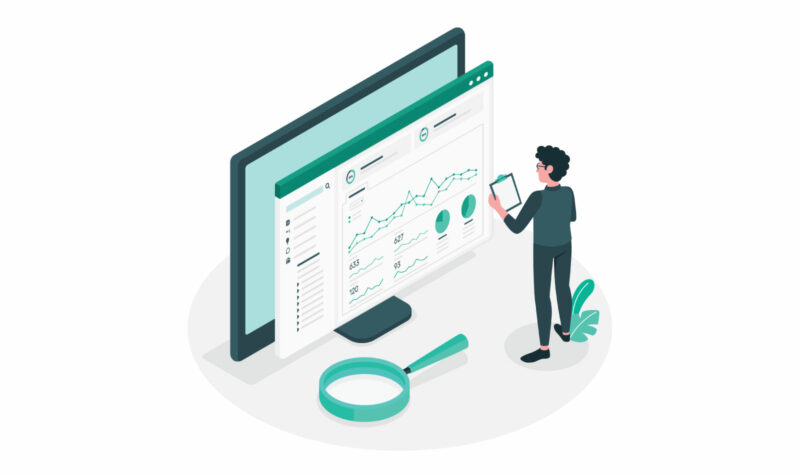
In this article
While social media marketing can offer a high return on investment, the path to reaping those rewards is anything but straightforward. That’s because quantifying the impact of social media marketing is difficult, and because you can use so many different KPIs (key performance indicators) to track your brand’s progress.
Converting leads into paying customers is one way to gauge a social media campaign’s efficacy. But metrics such as follower count and impressions can be equally important (or even more so) if your goal is to build customer loyalty, raise brand awareness, or provide customer support.
“If the goal is to build brand awareness on social media, reach might be the best metric to prioritize,” said Kelsey Gillhooley, marketing manager for brand and social at Talkspace. “Whereas if their ultimate goal is to increase sales, conversions and ad click-through rates would be more important.”
To measure the success of your brand’s social strategy, you need to set KPIs that correspond to your goals. But how do you know which KPIs are the most important for your brand?
That’s why we’ve created this guide. Below, we’ll cover which KPIs are the most important for which goals, so that you’ll know which KPIs are right for your brand.
What Are Social Media KPIs?
Social media KPIs are metrics that indicate how your social media platforms are performing. By choosing which KPIs are most important to your brand, and then tracking those KPIs, you can see how your social channels are performing over time, and then optimize those channels.
Social Media KPIs to Track
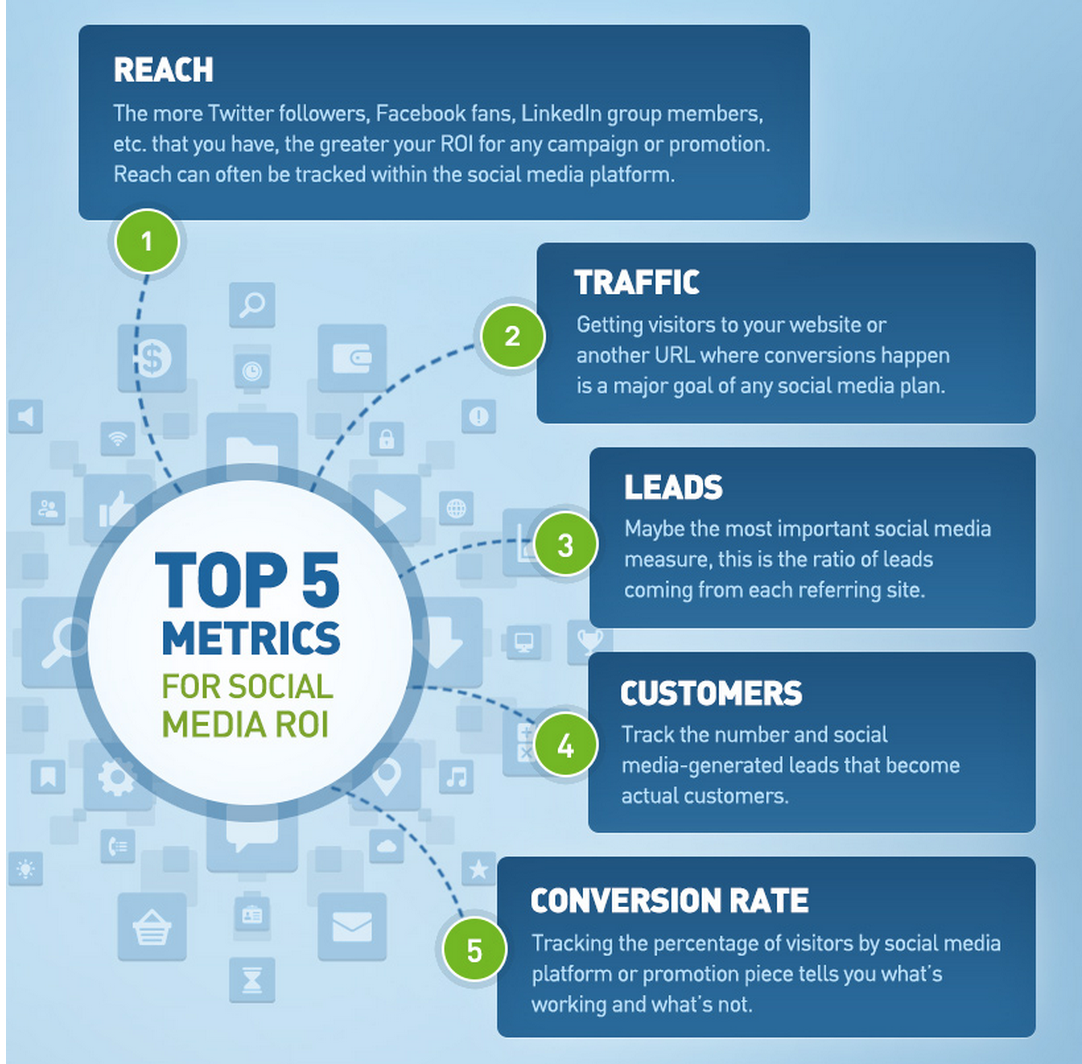
Selecting the right KPI depends on the social platform and the goal you’re trying to achieve. For example, views might be your top metric for short-form videos on TikTok, whereas the success of long-form videos on YouTube is measured by the number of minutes watched. You might even set KPIs specific to a campaign you’re currently running, such as a product giveaway or discount.
“Start with audience research and learn where your target demographic spends the most time,” said Gillhooley. “From there, decide on business goals for each channel and isolate the metrics that will help you measure your progress towards that goal.”
Let’s break down different KPIs and how they correspond to different brand goals.
Social Media Metrics for Reach

Reach refers to the total number of unique users who have seen your content and taken action, such as clicking a link or viewing the company’s social media profile. However, beware that reach is considered a “vanity metric” (a non-monetary metric that does not signify a real ROI) because likes, follows, and comments from social media users do not necessarily lead to conversions.
Impressions
Impressions are a key metric that helps brands determine whether their social media marketing efforts are reaching their intended audience. More impressions equal more visibility, so it’s an important proxy for measuring brand awareness.
What Are Impressions?
This refers to the number of times your content is viewed on social media feeds, regardless of whether users interact with it. For example, if someone simply scrolled past your content, this would still count as an impression. Also, a single person can register multiple impressions for one piece of content. This is why impressions are usually higher than reach.
Why Are Impressions Important?
Impressions are an important metric for measuring brand awareness. Even if your social media followers aren’t ready to engage with you yet, repeated exposure to your content builds brand recognition, increasing the chance that your brand will be top of mind when they are ready to buy.
How Do You Calculate and Track Impressions?
On most social media platforms, an impression is registered each time the content appears in someone’s feed. On platforms that don’t have a feed, such as Snapchat or IGTV, an impression is counted when someone views your social media “story.” Most platforms provide impression data on their analytics page.
New followers

A brand’s number of new followers is a way of measuring the growth of your social media audience over time, and making sure that your brand growth isn’t stagnating.
What Are New Followers?
New followers are people who have recently followed one of your brand’s social media channels. They’ll automatically see your latest posts in their newsfeed. Consequently, an increased follower count generally boosts every other social media KPI.
Why Are New Followers Important?
Brands are always looking to grow their follower count because it exposes their content to a larger audience. The more people see your content, the more likely they are to engage with it and become paying customers.
How Do You Calculate and Track New Followers?
Most in-platform analytics tools show you the number of new followers for your social media page. Note that this number can be a net positive, zero, or net negative.
Follower Drop-Off Rate
The follower drop-off rate measures how many people have unfollowed your account over a specific time period.
What Is a Follower Drop-Off Rate?
Expressed as a percentage, the drop-off rate measures the speed at which your social media account is losing followers relative to your previous follower count.
Why Is a Follower Drop-Off Rate Important?
High attrition suggests your content does not resonate with your audience. Perhaps the content isn’t relevant to them, your messaging is off-brand or unclear, or you’re targeting the wrong audience.
How Do You Calculate and Track the Follower Drop-Off Rate?
The follower drop-off rate is calculated as the number of followers you lost divided by the number of followers you started with.
Follower Growth Rate
Audience growth rate measures the total number of new followers on your social media account over a specific time period.
What Is the Follower Growth Rate?

Expressed as a percentage, the follower growth rate measures the speed at which your social media account is gaining followers relative to your previous follower count.
Why Is the Follower Growth Rate Important?
An increase in follower count indicates that your posts are generating high engagement. This means audiences find your content informative, useful, and/or entertaining, and you are most likely targeting the right audience.
How Do You Calculate and Track the Follower Growth Rate?
The follower growth rate is calculated as the number of followers you gained divided by the number of followers you started with.
Share of Voice
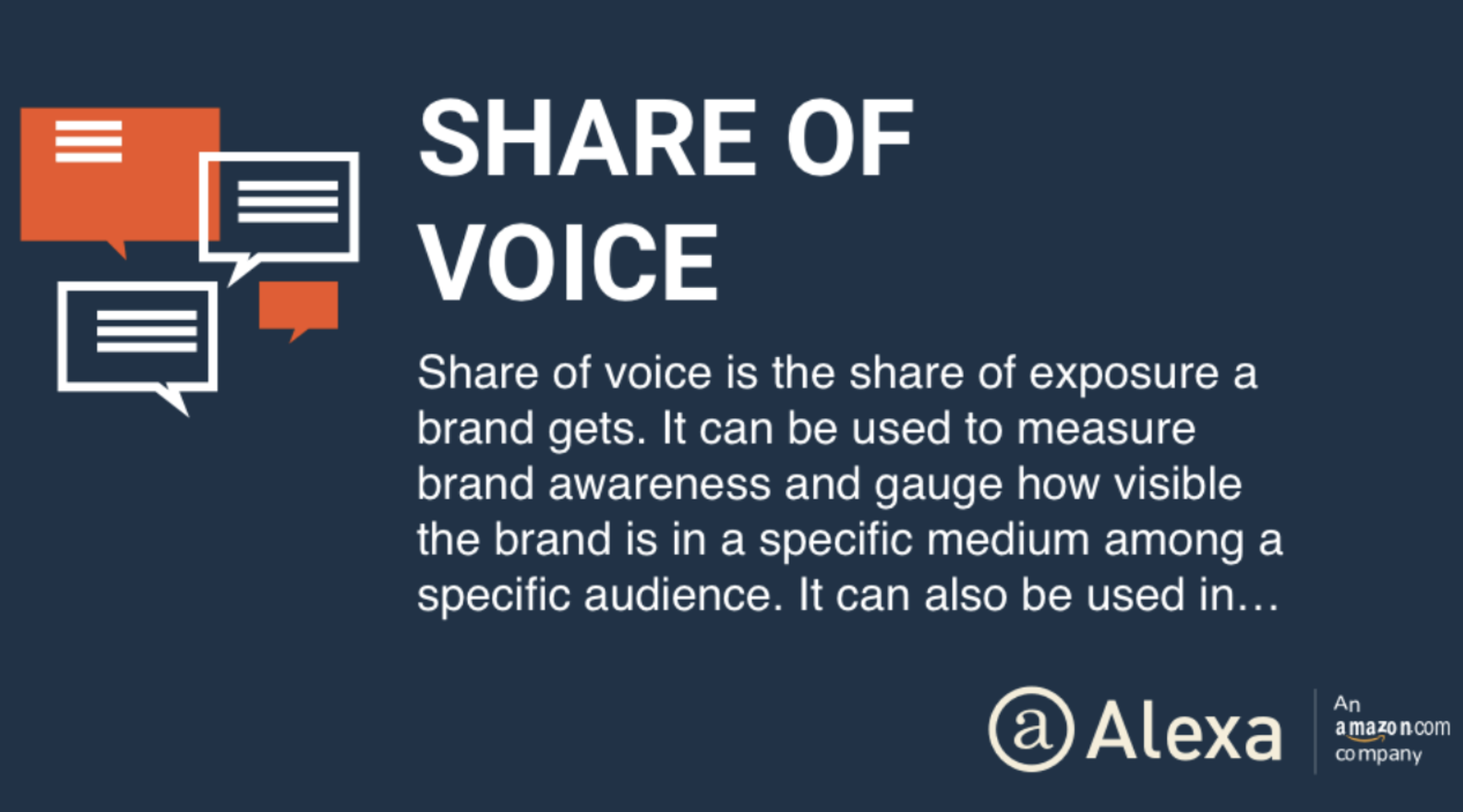
Share of voice (SOV) is a broad measure of the market your brand owns on social media or the extent to which you dominate the conversation in your industry compared to your competitors.
What Is Share of Voice?

Share of Voice not only tracks consumer sentiment of your business but your competitors, too. SOV also tells you which platforms you might be underutilizing and how effective your campaigns are in capturing a share of your competitors’ audience.
Why Is Share of Voice Important?
SOV is an important proxy for brand visibility as it measures the level of exposure relative to your competitors.
How Do You Calculate and Track Share of Voice?
SOV is measured by the number of times your brand is mentioned on social media and website traffic for certain keywords. It is usually expressed as a percentage of total mentions within an industry or among a defined group of competitors.
Social Media KPIs for Engagement
Social media engagement measures the interactions associated with your content, such as clicks or shares. Ultimately, engagement metrics are more important than reach because social media users who interact with a social post are more likely to convert into paying customers.
“Depending on the platform, a good engagement rate is anywhere between 0.5% and 5%,” said Amanda Hubilo, social media marketing manager at Hubilo. “Tracking high-level stats on a weekly and monthly basis can help you answer a lot of questions–for example, what type of call-to-action leads to the most clicks?”
Website Referral Traffic
Website referral traffic measures the number of times someone visited your website via a link on your social media profile, or searched for your website after seeing your post in their feed.
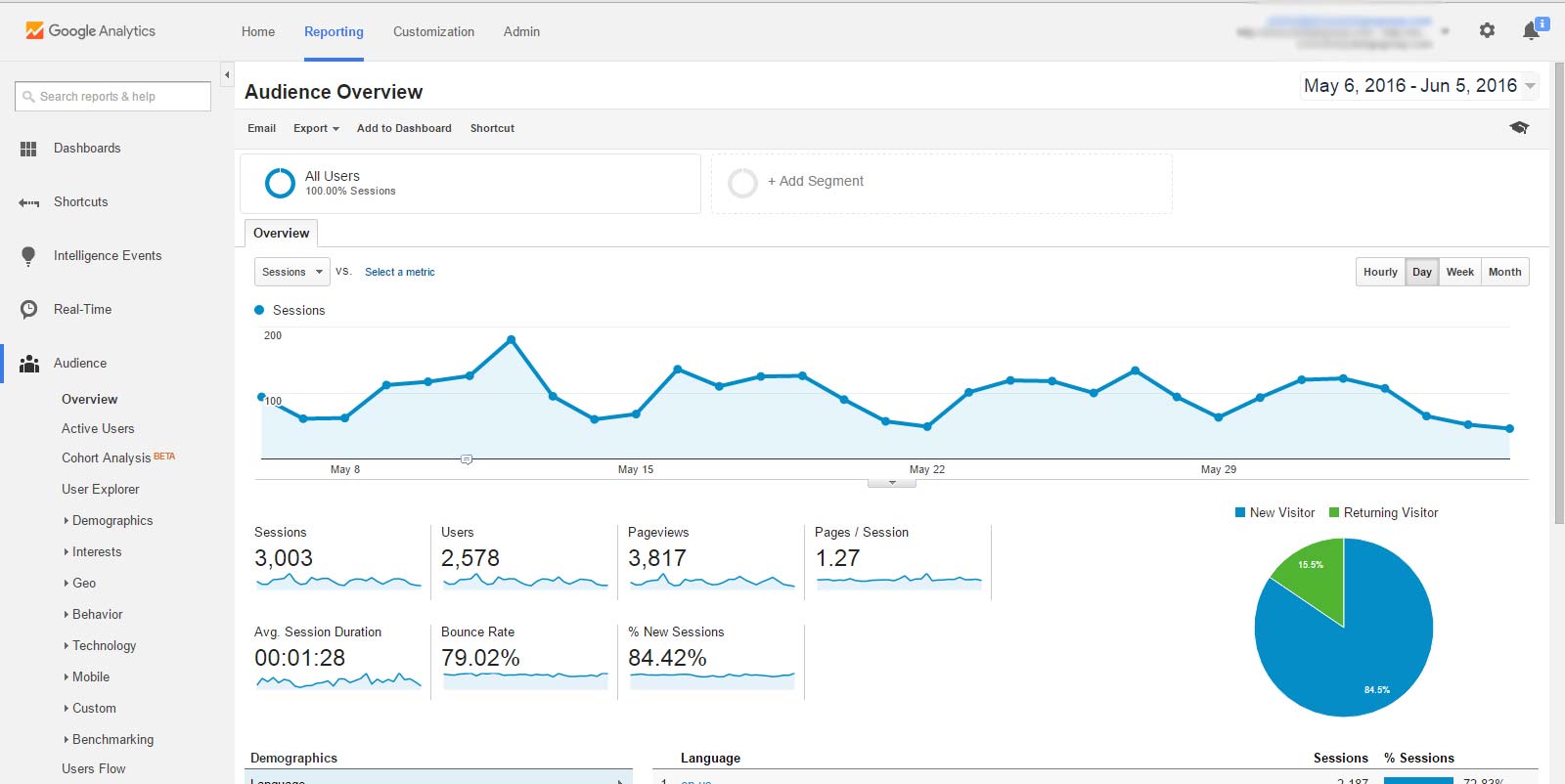
What Is Website Referral Traffic?
Website referral traffic determines whether your social media posts are successfully converting audiences to visit your website and take a given action.
Why Is Website Referral Traffic Important?
For most brands, the purpose of social media marketing is to ultimately attract site traffic. When people visit the company’s website, they can learn more about the company and possibly make a purchase.
How Do You Calculate and Track Website Referral Traffic?
Web analytics platforms show you where traffic is coming from and can attribute referrals to individual social media channels.
Clicks
Clicks can refer to any number of interactions on a social media post.
What Are Clicks?
A click can include a like, comment, or any other interaction. For example, someone might click to expand a tweet or view the rest of your Instagram caption. Or they might click on a link in your post to visit a page on your website.
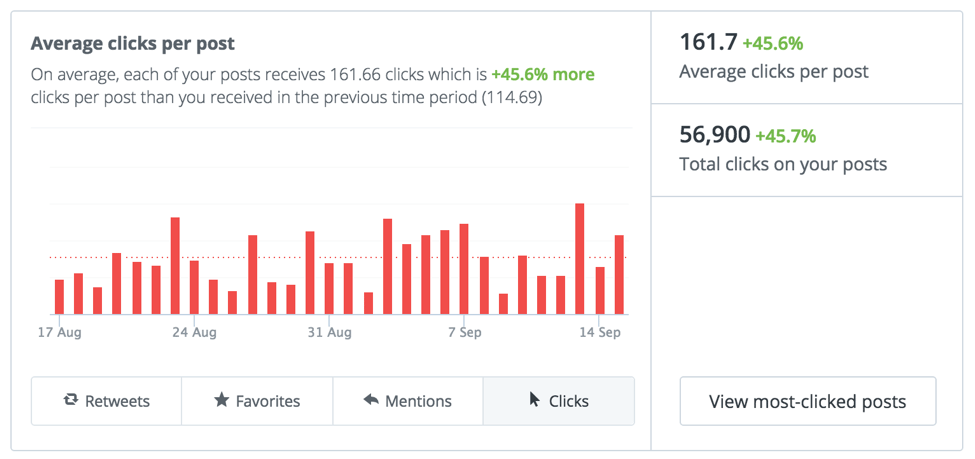
Why Are Clicks Important?
Clicks are a form of engagement. They indicate that someone not only viewed your post but interacted with it. Marketers include calls-to-action in social media posts to encourage people to click on links and complete an action.
How Do You Calculate and Track Clicks?
In-platform social media analytics can tell you the number of clicks for each individual social media post per time period or the overall number of clicks for all posts.
Mentions

Social media mentions refer to the number of times someone tagged your company in a post or used one of your branded hashtags. By examining mentions, you can gauge the overall consumer sentiment of your brand.
What Are Mentions?
Mentions occur when someone references your brand’s social media handles in a post or uses one of your branded hashtags.
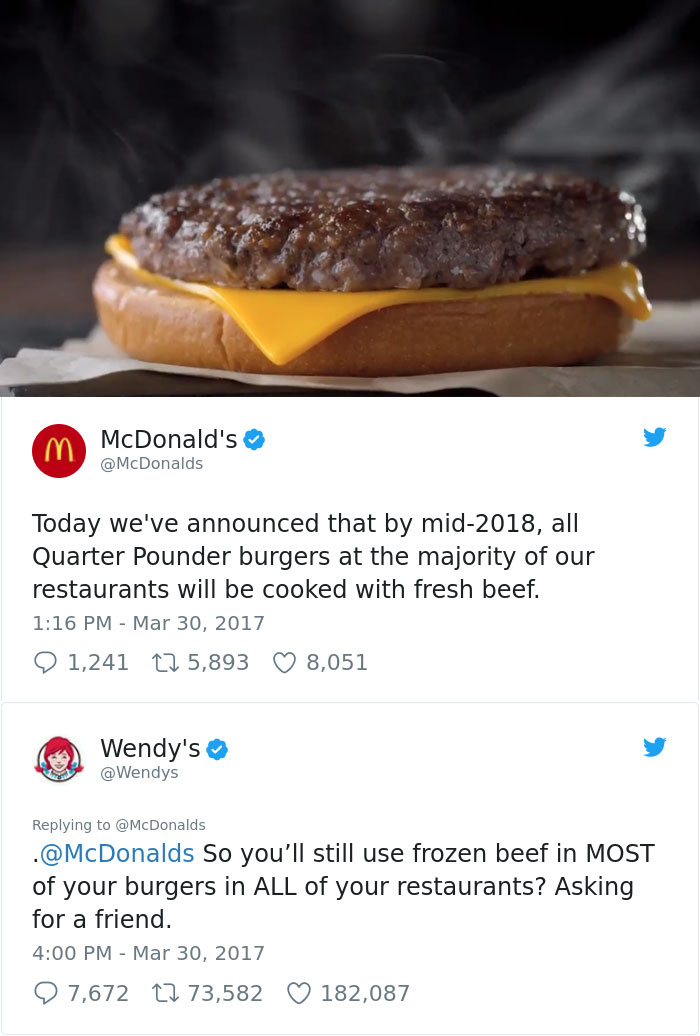
Why Are Mentions Important?
Mentions help organizations track overall brand sentiment as they typically constitute direct feedback or a request for customer support.
How Do You Calculate and Track Mentions?
Social media listening tools enable organizations to track the number of mentions per time period and also use natural language processing (NLP) to determine the sentiment of each mention.
Shares
Shares vastly increase the reach of your content because it exposes your post to the people who follow the person who shared it. With enough shares, your content might just go viral.


What Are Shares?
Shares measure the number of times someone reposts your content onto their own feed.
Why Are Shares Important?
Shares are the most powerful way to expand reach. Most of the time, shares indicate that your content resonated with the user to the point that they are willing to share it with their followers.
How Do You Calculate and Track Shares?
In-platform social media analytics can tell you the number of shares for each individual social media post per time period, or the overall number of shares for all posts.
Likes
Likes refer to the number of reactions your post garnered. It’s arguably a vanity metric because users can like a post without taking any other action.
What Are Likes?
Likes indicate an emotional reaction to the post. Most platforms including LinkedIn and Facebook now enable users to select from a range of reactions including “Happy,” “Sad,” “Angry” and so on.
Why Are Likes Important?
Social media algorithms automatically amplify content that engenders a lot of likes and comments, which increases reach. Likes indicate that your content was sufficiently engaging to prompt an emotional reaction.
How Do You Calculate and Track Likes?
You can view the number of likes on your posts by looking at each individual post or by using your in-platform social media analytics tool.
Comments
Comments on posts are a valuable source of customer feedback. Ideally, you want your posts to spawn conversations. Comments also increase the reach of your posts because the commenter’s followers will see the post in their newsfeed.
What Are Comments?
Comments represent written reactions to a social media post. They can be positive, negative, or neutral.

Why Are Comments Important?
Comments help brands start conversations with their followers, thereby turning social media into a two-way street.
How Do You Calculate and Track Comments?
You can view comments by clicking on each individual post. You can also track the overall number of comments for all social posts using your in-platform social media analytics tool.
Profile Visits
Profile visits enable people to find out more about your business and potentially even visit your website, which increases website referral traffic.
What Are Profile Visits?
This refers to the number of social media users who viewed your social media profile, typically after seeing your content.
Why Are Profile Visits Important?
Profile visits indicate your followers are getting one step closer to converting. When someone visits your website, they are more likely to complete a given action (i.e. subscribing to your newsletter) and are more likely to intend to make a purchase.

How Do You Calculate and Track Profile Visits?
In-platform social media analytics can tell you the number of profile visits per time period.
Social Media Metrics for Conversions
Conversions occur when someone who has interacted with you on social media takes a desired action as a result of your marketing efforts. Let’s look at how you can gauge this.
Conversion Rate
A conversion occurs when a social media user performs a predefined action, such as signing up for a free trial or making a purchase. Generally, a successful conversion rate for social media is anywhere from two to five percent.
What Are Conversion Rates?
Expressed as a percentage, a conversion rate measures the proportion of website visitors who took a given action as a percentage of all website visitors.
Why Are Conversion Rates Important?
Conversions are the ultimate goal of any social media marketing campaign as they help to generate new leads and bring in revenue.
How Do You Calculate and Track Conversion Rates?
Third-party social media analytics tools that are integrated with your website will automatically track how many website visitors take a given action.
Leads
When someone shares contact information that you can use to follow up with them to nurture a sale, that counts as a lead. For example, they might fill out your contact form or submit their name and email to view a piece of gated content.
What Are Leads?
Leads represent potential buyers who have shown an interest in your brand by taking a given action.
Why Are Leads Important?
Leads must be nurtured so that they will eventually convert into paying customers. This is done using email marketing, social media customer support, and ad retargeting.
How Do You Calculate and Track Leads?
Lead acquisition tools can provide in-depth data on who is visiting your website, their browsing habits, and what other websites they have visited.
Sales
Conversations are tracked with the hope that conversations will lead to sales. This is one of the best indicators that your social strategy is working.
What Are Sales?
Sales represent purchases made by individuals or other businesses.
Why Are Sales Important?
Sales generate revenue for the organization and prove the ROI of social media marketing.
How Do You Calculate and Track Sales?
You can track the number of conversions that resulted in sales by using a CRM tool that integrates with your social media accounts.
Click-Through Rate (CTR)
Expressed as a percentage, this metric tells you how effectively your social content drives people to your owned web properties.
What Are Click-Through Rates?
CTR measures how many people click on a social media post or ad as a percentage of all the people who saw it.
Why Are Click-Through Rates Important?
Click-Through Rate indicates whether or not people are responding to your call-to-action (CTA). A low click-through rate means the CTA might be unclear or uncompelling.
How Do You Calculate and Track Click-Through Rates?
The formula to calculate CTR is the number of clicks divided by total impressions.
Bounce Rate
A high bounce rate could indicate a poor user experience, disorganized information, or off-brand messaging.
What Are Bounce Rates?
Bounce rate is the percentage of website visitors who navigate away from the site after viewing only one page.
Why Are Bounce Rates Important?
If most prospects leave your site quickly, they are far less likely to convert into paying customers.
How Do You Calculate and Track Bounce Rates?
Web analytics tools like Google Analytics can show you the bounce rate for each individual web page as well as the website overall. A website’s bounce rate is calculated by dividing the number of single-page sessions by the number of total sessions on the site.
Cost Per Click (CPC)
CPC is determined by a range of factors including the day of the week, time of day, how many users you’re targeting, how relevant your ad is to your target audience, and even what industry you’re in.
What Is Cost Per Click?
When running paid ads, cost per click refers to a fixed rate the advertiser pays the social media platform each time someone clicks on their ad.
Why Is Cost Per Click Important?
Cost Per Click determines how much money you will have to spend whenever a prospect clicks on your ad. CPC determines the overall paid marketing budget.
How Do You Calculate and Track Cost Per Click?
Social media ad manager tools are platforms for running social media ads and tracking ad analytics, including CPC. On Facebook, most ad costs are measured in cost per click or cost per thousand impressions (CPM).
Social Media KPIs for Loyalty
While social media platforms are great for enabling potential customers to discover your brand, they also enable brands to build loyalty with their existing customers by keeping them engaged. Loyal customers are more likely to share a positive experience with a brand on social media, write reviews, and recommend the brand to their friends.
Reviews and Testimonials

Reviews and testimonials are a great way to track customer sentiment. Reviews also help build trust and convince potential customers that you provide a good customer experience.
What Are Reviews and Testimonials?
Reviews and testimonials are sources of primary feedback from customers. They indicate how well or how poorly your business is doing at satisfying its customers, and are a valuable source of suggestions for improvement. Customers can leave reviews of your business on social media, your website, or general review sites such as Yelp or Google Business.
Why Are Reviews and Testimonials Important?
Reviews are valuable signposts for how your business is doing. By analyzing the overall sentiment of reviews, you can determine if your business is providing a positive or negative customer experience overall. Reviews are important because they are publicly visible to current and prospective customers. A preponderance of negative reviews has the potential to jeopardize your reputation.
How Do You Calculate and Track Reviews and Testimonials?
You can track reviews and testimonials by using a social media listening tool. These tools track mentions of your brand on social media networks and are often equipped with natural language processing (NLP), which analyzes the overall sentiment of each mention. Another way to find reviews or testimonials outside of the business’ owned properties is to use Google Alerts. This content notification service sends you an email when it finds new content–such as web pages, newspaper articles, or blogs–related to your designated search term.
Customer Satisfaction Score (CSAT)
Expressed as a percentage, CSAT measures what proportion of your customers were satisfied with your product or service.
What Is a Customer Satisfaction Score (CSAT)?
A customer Satisfaction Score is one of the most straightforward ways to measure overall customer satisfaction.
Why Is a Customer Satisfaction Score (CSAT) Important?
CSAT is important because it gives you major clues about customer retention and lifetime value. Satisfied customers are more likely to remain loyal and make repeat purchases, whereas dissatisfied customers will take their business elsewhere.
How Do You Calculate and Track a Customer Satisfaction Score (CSAT)?
CSAT is derived via one or more variations of this question: “How would you rate your overall satisfaction with [good/service] you received?” The results are then averaged to give a composite customer satisfaction score.
Net Promoter Score (NPS)
NPS measures how likely a customer is to refer your business to a friend, typically on a scale of 0-10, with 0 denoting “highly unlikely” and 10 meaning “highly likely.”
What Is a Net Promoter Score (NPS)?
Your NPS indicates how likely a customer is to be a brand advocate. This can help when deciding which customers to target during a referral marketing campaign.
Why Is a Net Promoter Score (NPS) Important?
First developed in 2003 by Bain and Company, NPS is often held up as the gold standard customer experience metric.
How Do You Calculate and Track Your Net Promoter Score (NPS)?
NPS is expressed as a number ranging from -100 to +100. Depending on the rating they give during the survey, customers fall into one of three categories to establish an NPS score: promoters (score of 9-10; very happy customers who are willing to advocate for your brand), passives (score of 7-8; satisfied customers who are not happy enough to refer their friends), detractors (0-6; unhappy customers who are unlikely to buy from you again and may even discourage others from buying from you).
How To Determine the Social Media Metrics that Are Important to You
Picking the right social media KPIs is just as important as picking the goals you set, as KPIs allows you to collect accurate data and adjust your social media activities accordingly. Here’s how to select the best metrics that align with your business goals.
Define Your Goal
Social media reporting metrics are a chance to demonstrate the value of your work. First, define your social media goals—is it brand awareness, lead generation, or customer loyalty?—and select metrics that align with those goals.
Choose Your Network
Pick three or four social media platforms to focus on. When considering different social platforms, consider whether the user personas match your ideal customer profile. Consider things like gender split, age groups, number of monthly active users (MAU), usage habits, and countries where the social platform is permitted (most Western social media platforms are banned in China, while Russia has banned Facebook and Instagram).
Evaluate Your Tracking Setup
Determine how you’ll track your social media metrics. It’s best to use a social media analytics tool that pulls social media KPIs from all your different accounts so you can see all your data in one place and compare performance across platforms. You can also customize your dashboards to highlight the metrics that matter most to your organization.
Start With 2-3 Metrics
Isolate the top 2-3 KPIs that are the most pertinent to your business goals and focus on those. Tracking too many metrics makes for noisy data that isn’t necessarily actionable. For example, if your goal is to increase customer engagement, your top three metrics would be click-through rate, website referral traffic, and comments.
How To Track Social Media KPIs
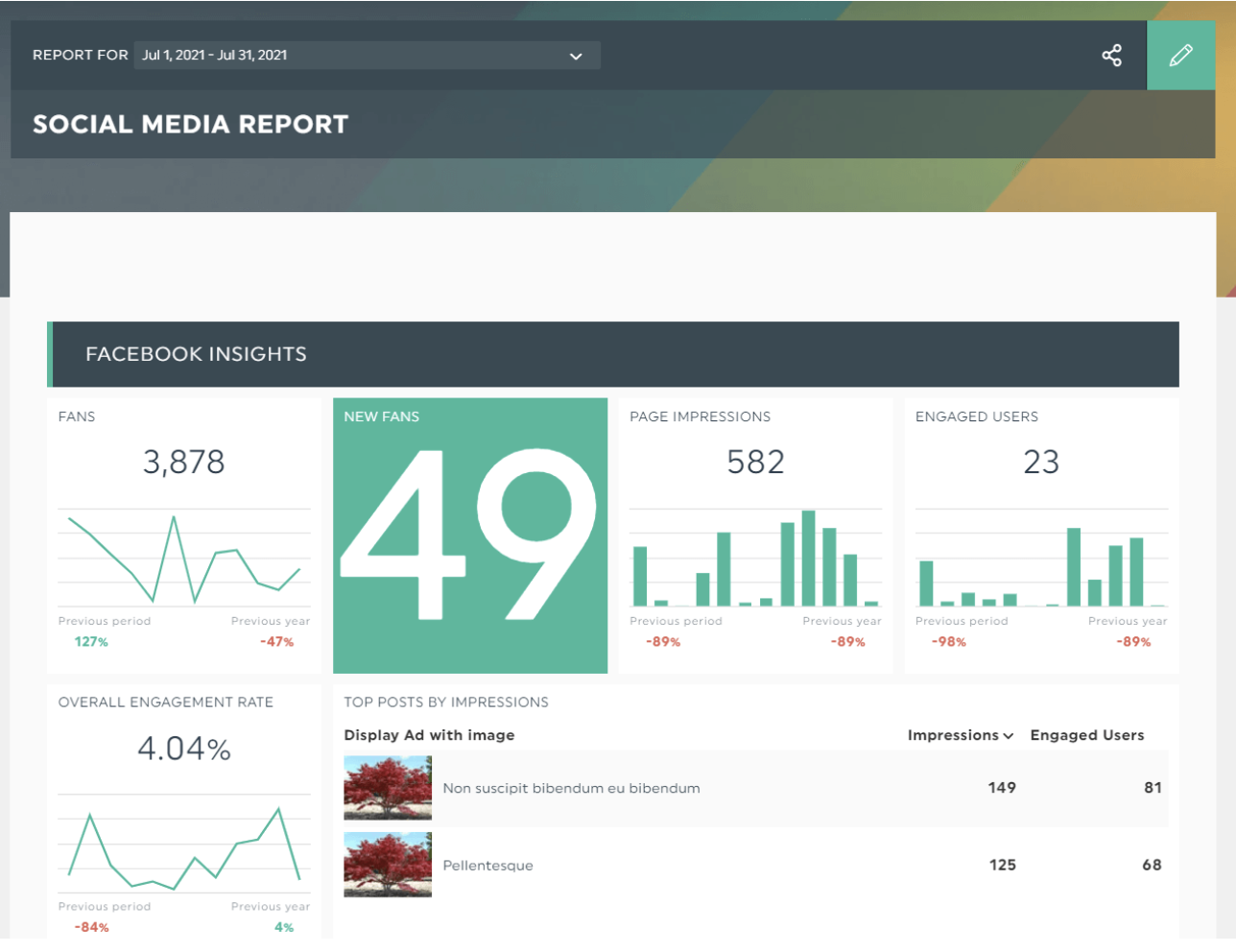
There are a variety of analytics tools you can use to track your social media performance. While each social networking platform offers built-in analytics, some organizations opt for third-party analytics tools, as these provide more customization options.
In-Platform
Social media platforms offer basic analytics tools to track engagement levels over a specific time period. For example, you can track likes, follower count, comments, shares, direct messages, and other metrics. However, bear in mind that these canned analytics dashboards may not show the metrics you care about most. You might need custom analytics tools for that.
Third-Party Analytics Tools
Social media analytics tools allow you to build custom dashboards and reports and automatically calculate derived metrics such as share of voice or social conversions. The main advantage of using an analytics tool is that you can evaluate the overall performance of your social media marketing by combining data from all your social platforms. (Here is a post explaining what a social media marketer actually does.)
Custom Reporting
Custom reporting tools make it easy to create performance reports to share with other team members. You can also focus on the metrics that matter most to the business rather than relying on canned reports.
Social Media KPI Templates
Since you may be tracking KPIs on a daily or weekly basis, templates are a useful tool for repeatable reporting as you’ll know right away which KPIs to highlight. By tracking the same KPIs consistently, you can evaluate the brand’s social media performance over time while also deriving larger trends on a monthly or annual basis. A KPI template can be a simple Excel spreadsheet containing key metrics and preset formulas that calculate user engagement rate or change over time.
FAQs About Social Media KPIs
We’ve got the answers to your most frequently asked questions.
How Important Are KPIs When It Comes to Social Media Marketing?
KPIs are essential to tracking the performance of your social media campaigns and determining the overall ROI of your social media efforts. Marketers use social media KPIs to determine whether their social media persona resonates with their audience, how many people are engaging with their content, and how many conversions they’ve achieved from organic content and paid ads.
Is There a “best” KPI for Social Media?
The ideal KPI depends on your business goals. For example, if the goal is to build brand awareness, then the most important KPIs pertain to reach–impressions, likes, views, and so on. However, if your goal is conversions, then the most important KPIs are website referral traffic, bounce rate, leads, click-through rates, and conversion rates.
Are Social Media Metrics Hard to Set Up?
Every social media platform offers its own analytics platform. However, if you want to monitor custom metrics, you may need to set these up in a social media analytics dashboard.
Since you’re here…
According to LinkedIn, social media marketing skills are the most in-demand marketing skills this year, and jobs are plentiful. Our Social Media Marketing Certificate Course will prep you for an industry job in just 8 weeks. Don’t take it from us – our student reviews are glowing for a reason. We get people where they want to go, ASAP.
![113 Digital Marketing Interview Questions [2022 Prep Guide]](png/113-digital-marketing-interview-questions-2022-prep-guide-380x235.png)

